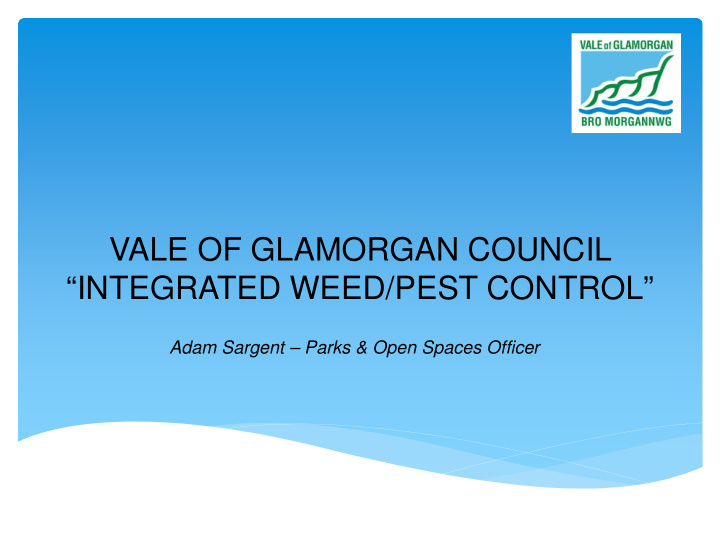



VALE OF GLAMORGAN COUNCIL “INTEGRATED WEED/PEST CONTROL” Adam Sargent – Parks & Open Spaces Officer
The Vale of Glamorgan manages its use of Pesticides by following………………… THE CODE OF PRACTICE FOR USING PLANT PROTECTION PRODUCTS (Amenity Areas)….Jointly prepared by: This Code Reflects the following laws and sets out “Best Practice”: Food & Environmental Protection Act 1985 Control of Pesticides Regs. 1986 (as amended) …and many, Health & Safety at Work Act (1974) many, many, Control of Substances Hazardous to Health 2002 many more Personal Protective Equipment at Work Regs. (1992) Wildlife & Countryside Act 1981 (as amended)
CODE OF PRACTICE FOR USING PLANT PROTECTION PRODUCTS (Amenity Areas) Gives Clear Guidance on: 1. Training & Certification 2. Planning & Preparation 3. Working with Pesticides 4. Disposing of Pesticide Waste 5. Record Keeping
CURRENT & FUTURE PESTICIDE OBJECTIVES OF THE VALE OF GLAMORGAN COUNCIL To stop the use of pesticides - wherever possible To minimise / reduce use of pesticides To use alternative methods - wherever possible To look for and use best practice To continually assess methods ……I will now expand on these points…..
Stop the use of Pesticides - wherever possible We do not herbicide spray any lawned open spaces Exceptions: We do not herbicide spray sports pitch • fine-turf markings • Cricket outfield We do not spray for pests (green fly / black fly)
Minimise / reduce use of Pesticides …..by aiming for an integrated pest management Legal controls Biological controls Cultural controls Mechanical and physical controls Chemical controls
Minimise / reduce use of Pesticides …….continued Seasonal bedding areas now Wildflower flower areas Seasonal bedding areas now herbaceous borders
Minimise / reduce use of Pesticides …….continued Parks Dept – usage per annum – 150 litres (approx) Of this approximately 80 litres are Glyphosate based What is Glyphosate? Current usage in perspective: …..VoG covers approximately 33,500 hectares …..approximately 12% of this is farmed as arable land ....which would equate to 4,020 hectares ….using the same dose rate at 3 applications per year ….for each litre used by parks 377 litres are used elsewhere This does not take into account private use ( 55,000 households )
Minimise / reduce use of Pesticides……continued PESTICIDE USE WITHIN THE HIGHWAYS DEPT 1030km Carriageway treated 799km Footway treated 3 Treatments per year….......... …….Using Weed-IT technology Using…Dakar Pro (Glyphosate ai ) • Highest load glyphosate for enhanced performance • Clean label – no hazard symbols • Soluble granule formulation in easily • With unique optic sensors – detects disposable plastic bags chlorophyll • Safer and easy to use 97% reduction in • The most environmentally efficient method packaging of weed control • No triple rinsing or disposal of containers • With a typical chemical reduction of 70% required. being made.
Use alternative methods - wherever possible Mulch Shrub Beds Improve Field Husbandry Use Mechanical Sweeper Mechanical Methods Independent Fine Turf Analysis
Look for and use Best Practice by……….. ...........monitoring changes in legislation ...........attending events such as the “Green Project” ………learning / sharing with other Welsh authorities ………ensure all staff are trained and competent ………discussing with suppliers & reading trade magazines ………..working with the Amenity Forum Green Space Wales Managing and developing Green Spaces
www.amenityforum.co.uk • Formed as an independent body to bring together professional organisations with an involvement in the amenity horticulture sector. • An industry led project to reduce the environmental impact of pesticides • This forum is now fully recognised as the voice for the sector on matters relating to weed, pest & disease control in the amenity sector • 45 organisations are direct members representing manufacturers, distributors, contractors, local authorities and a range of other bodies.
www.amenityforum.co.uk • To promote and encourage proper and responsible use of pesticides and integrated methods for the control of pests, weeds and diseases • To lead, coordinate and encourage achievement of “Best Practice” objectives in Amenity pesticide use • To coordinate and encourage the establishment of sustainable qualifications, training and CPD activity, specifically for the Amenity sector • To organise activities within the Amenity Forum membership and linked organisations. Secretary: Alan Spedding: Alan.Spedding@amenityforum.net
Continually Assess / Monitor Methods …….Use the “Green Dragon” Standard “ethos” ……which is based on the ISO14001 European Environmental Standard Level One - Commitment to Environmental Management Level Two - Understanding Environmental Responsibilities Level Three - Managing Environmental Impacts Level Four - Environmental Management Programme Level Five - Continual Environmental Improvement The Visible Service Team within the Vale of Glamorgan achieved Level Five Note….we now use the “ethos” only due to financial constraints (registration / external audits
Continually Assess / Monitor Methods ……continued …….Use the “Green Flag” Standard Assessment Criteria 1. A Welcoming Place 2. Healthy, Safe and Secure 3. Clean and Well Maintained 4. Sustainability 5. Conservation and heritage 6. Community involvement 7. Marketing 8. Management
Thank you for listening, and I hope it has been informative …….any questions? Adam Sargent – Parks & Open Spaces Officer
Recommend
More recommend